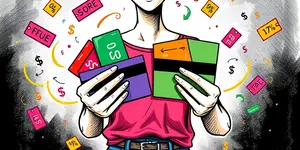
Credit shapes our financial landscape more than ever. As balances climb and delinquencies rise, proven credit strategies to eliminate debt become essential. This guide offers actionable advice, solid data, and best practices to empower you on a path toward true financial freedom.
Credit card debt in the United States has grown steadily, with outstanding balances expected to hit $1.1 trillion by end of 2025. While this represents a slower growth rate than the double-digit surges seen in prior years, it underscores continued consumer reliance on revolving credit.
By late 2024, Americans held 554.5 million active cards, up from 451.6 million in 2020. Non-prime borrowers lead this uptick, with their balances projected to grow by 8% in 2025. Mortgage delinquencies have edged upward in early 2025, even as auto, personal, and bankcard delinquencies show slight improvements.
A Federal Reserve survey from 2024 revealed that 19% of U.S. adults are "just getting by," while 8% find it difficult to manage daily expenses. Sociodemographic trends confirm that older individuals often fare better financially, thanks to accumulated savings and home equity.
When leveraged wisely, credit unlocks opportunities and reduces stress. Responsible use provides:
Conversely, misuse can lead to crippling interest charges and long-term credit damage. Late payments remain on your file for up to seven years, potentially impacting job prospects and insurance premiums. Unchecked balances can spiral into collections and legal action under the Fair Debt Collection Practices Act.
Adhering to foundational credit principles will bolster your financial health. Review the key guidelines below:
Adopting these habits creates a sturdy financial foundation. Small adjustments, like setting calendar alerts or automating payments, can yield significant score improvements over time.
Implementing a clear repayment plan is crucial to regaining control. Begin with the “avalanche” method: prioritize debts with the highest interest rates to minimize total interest paid. Simultaneously, maintain minimum payments on other accounts to avoid negative marks.
If balances feel overwhelming, consider consolidation options. A personal loan with a lower fixed rate can replace multiple high-rate cards, simplifying payments and potentially saving hundreds in interest. Nonprofit credit counseling agencies also offer free or low-cost guidance—never hesitate to seek help when needed.
Your credit score hinges on five factors: payment history (35%), utilization (30%), account age, credit mix, and new inquiries. To improve or maintain your score, focus first on timely payments and low utilization.
Regularly check your credit reports for inaccuracies—if you spot an error, dispute it promptly. For newcomers to credit, secured cards or credit-builder loans can establish a positive record. Over time, these efforts compound, unlocking better rates and terms for mortgages, auto loans, and beyond.
Knowledge is the bedrock of financial resilience. Learning to budget, track spending, and forecast expenses prevents surprises and keeps credit usage in check. Even modest savings contributions or side-income projects can create emergency cushions and reduce reliance on credit cards.
Educational resources, workshops, and reputable online courses can deepen understanding of interest mechanics, amortization schedules, and investment basics. Ongoing learning empowers you to make informed decisions, curbing the cycle of debt and fostering long-term stability.
Leverage these protections and support systems. Understanding your rights and options arms you against unfair practices and guides you toward legitimate assistance.
Becoming debt-free demands discipline, strategy, and patience. By adopting core credit principles, improving financial literacy, and pursuing systematic debt reduction, you can lift the burden of high-interest balances and build lasting wealth. Start today: review your credit report, set realistic goals, and enlist support when necessary. Your future, free from mounting debt, begins with informed, responsible credit use.
References













